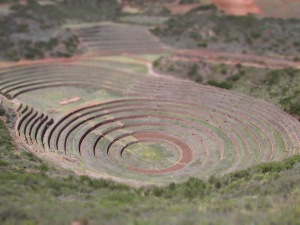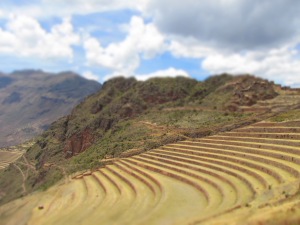We sat side by side eating in the school cafeteria. Amicably chatting about the Peace Corps projects like the Spelling Bee we had just judged, when the topic of conversation turned to the upcoming Christmas vacations.
“Rick and I are going to Perú…”
I jolted for my purse to extract my current read, Turn Right at Manchu Picchu by Mark Adams. Without much thought I blurted out the question of if I could go with them. And just like that I was planning my first trip into South America, to the land that has always been shrouded in mystery, intrigue and beauty by the larger world.
Deep velvet maroon and sand hills calmly swam beneath the plane and suddenly jumped upwards into the stone grey Andes mountain range where I knew what many South American travelers call “the crown jewel” lay safely tucked away. As we disembarked into what is the smallest airport I’ve been in to date, I popped another dully sweet coca hard candy into my mouth, weary of the altitude sickness I’d been constantly warned of. The smooth hills surrounding the airport melted into an urban center which swiftly changed into a historic center as the taxi bumped along a cobblestone street and into a busy plaza. Taking a sharp inhalation of the painfully thin, cold air I was momentarily transported back to my study abroad home of Granada, Spain. Rolling hills jam packed with crisp white houses and winding cobblestone streets framed the entire city of Cusco; a city so unapologetic of its genuine charm I was happy to wonder the side streets until I found the hostel. Sipping warm coca tea I sat next to a squat, fragrant Christmas tree decorated with hundreds of small knitted llamas and colorful lights, waiting for my travel partners to arrive. Old and new faces flooded into the room and we ventured out into the unseasonable hail storm to find a hot meal of alpaca stew, potatoes and purple chicha. For the next few mornings a cool white light streaked into our dorm alerting us that old ancient wonders were waiting for us to explore: Ollantaytambo, Pisaq, Cusco, The Sacred Valley, Chincero, Sacsayhuaman– all Incan marvels– all easily within our grasp. Smooth stones seamlessly formed giant fortresses, towns perched upon mountains and Pre-Columbian temples dedicated to the penetrating sun that shone above us. Each place presents the Incan’s ingenious tenacity that still mystifies and challenges our modern sense of genius. Clusters of loud local vendors swarmed the entrances, selling choclo (Incan corn), florescent yellow Inca Kola and colorful woven goods. Llamas and alpacas lazily lifted their long necks to throw us annoyed looks as we snapped our tourist pictures while local construction workers laughed at our excitement of trying to capture their mundane. Tour guides embodied Incan traditions and beliefs, calmly explaining the basis of their culture with cautious eyes and mischievous grins that swelled up into their tan, sharp cheekbones.
The dull roar of ATVs flooded the otherwise serene air. In a line we whizzed by an expansive brown patchwork of barren potato fields– the occasional farmer pausing their work to wave. Massive mountains jutted out of these flat fields, snow barely topping their summits. The Andes mountains are so close to the equator that snow can only stick to their peaks that lie above 5,000 meters above sea level, causing them to loom in an domineering manner. As we reached our destination we curved into the mountains and a huge smile broke out onto my face expressing my sheer amazement and appreciation at the wonders of our natural world, though no one could see it through my helmet. We winded down into a steep desert valley and began to shed our layers as the temperature rose with every downward spiral. Suddenly square upon square of blinding white stretched before us. Women with large straw hats crouched over their families blocks of salt, hoisting the wet minerals into piles to dry. Incan created and now managed by the pueblo of Maras this salt mine has been preserved for thousands of years. We walked along the narrow, crunchy paths snapping pictures and bought salt as a souvenir. During the return trip via dirt back roads a familiar sensation of lightness welled in my chest. There are certain moments and experiences that remind me that there is joy to be found in traveling, a sensation which hums a foreign yet familiar tune and floats in and out of the flurry of the fascinating newness you busy yourself with, desperately trying to absorb all that you can before your time is up. Yet, it tends to be in the calm and quiet moments, like riding along dirt roads with nothing but a motor purring and the world’s longest mountain range by your side, that clears your mind, allowing your ear to become attuned and you actually can listen to the joy of travel.
Our last night in Cusco was a blur of clothes, supplies and backpacks with their guts sprawled out on the squeaky hardwood floors. We were splitting up the next morning, Jaleel and I would be taking the train to save money and time while the others went on to hike the Incan Trail. An early, dark morning lead us into a colectivo bus that was going to the train station. Wedged between construction workers in bright green gear, clutching bottles of acid yellow Inca Kola we all drifted into a hazy sleep as the bus bumped along the serpentine roads out of the clustered city of Cusco and into the pale pink sun rising over the Andes where our friends were most likely beginning their trek.
Electric blue train compartments lined the tracks as hot steam rose in stalks into the cool drizzle that began to fall. We anxiously waited our turn to board– pan flute covers of classic 80s songs dominated the small waiting room. Incredibly steep stony cliffs hung over the tracks, only parting briefly to expose the river that carved them so long ago. The stewards came by and offered us coffee and local snacks to munch on while we sailed along, our anticipation rising with our altitude. Leaving the pueblo of Aguas Calientes the next morning we ascended the last stretch of the Incan Trail into the cloud forests which protected the Incans from the Spanish so many, many years ago. Stray dogs accompanied us up as we raced against the printed time on our tickets. We only had an hour to climb La Montaña de Manchu Picchu. Hoards of people mobbed the entrance of the park, unrecognizable languages and passports flew in the air as we scurried along the path trying to reach the entrance of La Montaña, bypassing a large grassy plaza that lead us to the ticket booth. We began to climb the terrifyingly steep and slick stone steps leading upwards. As the air grew thinner and the clouds thicker we questioned our decision and asked ourselves if we should call it quits and return to the city itself. Gasping for air that wouldn’t feel like knives in my lungs we paused and willed the clouds to part so that we could get a view of the famous ruin while we wandered around the summit. All kinds of accents swarmed the summit: Spanish, Australian, Colombian and a ultimately friendly Argentinean with his omnipresent selfie-stick who ended up becoming our travel partner for the rest of the day. As we happily reached semi-flat ground after climbing to the top of La Montaña we strolled back towards the large grassy plaza we had rushed by earlier. The clouds suddenly shifted in the wind and the iconic imagine of Manchu Picchu lurched into plain sight. We all froze, not believing it had been there the whole time. In an instant all of the factoids, histories and mysteries that had been buzzing in my head in preparation for meeting the famed Manchu Picchu fell deadly silent. Lush green grass patterned by the stone walls amplified the plateau between the two mountains and we stood in silence, each of us having our own moments of absorption of the beautiful scene in front of us.
Beauty is a physiological response. Beauty is the paradox of the body processing sensory details, causing our brains to pit physical data and emotion against each other. Beauty is a poignant thing based in our past experiences– mediated by what our eyes have already seen and processed. Beauty, in an instant, collides our past and our present in the simple blink of an eye. Our personal perceptions of beauty transcend layer after layer of personal opinion and general history– manifesting itself in the age old adage that beauty is in the eye of the beholder. Yet, an absurd number of people agree and feel the same pull towards certain objects, such as the famed ancient wonder of the world, Manchu Picchu. Manchu Picchu and Perú at large possess a particular brand of magnetism, something that lies more deeply than in its dramatic and photogenic physical beauty. They embody a captivating story, a continuing dialogue between its Pre-Columbian and Colonial histories and have made them relevant here, in this present moment in time. It’s a dialogue embodied in every colorful and detailed article of woven llama wool, heavily felt in the humbling presence of the giant Andes and softly whispered in every fleeting moment of Peruvian everyday beauty.






Great Post